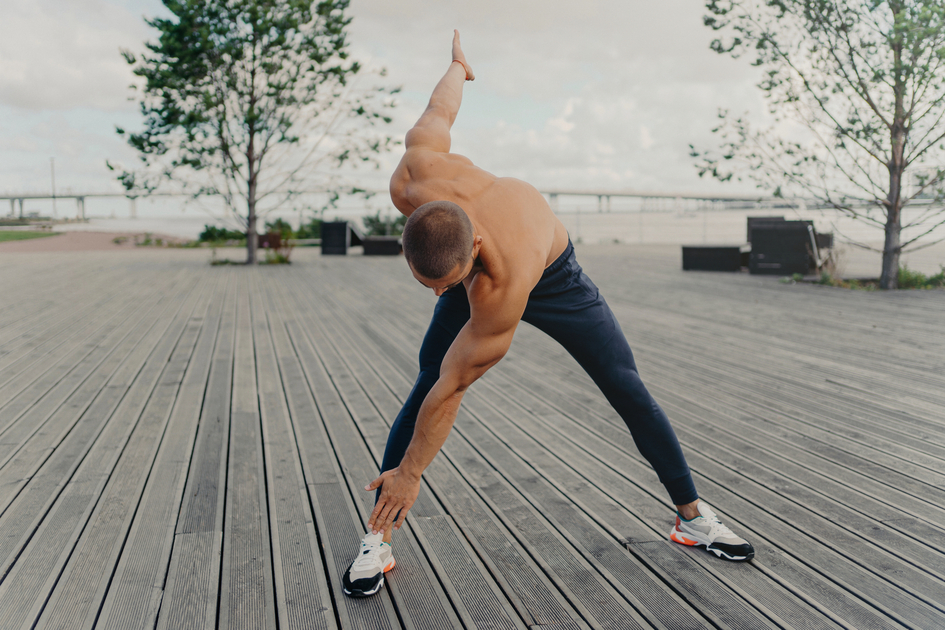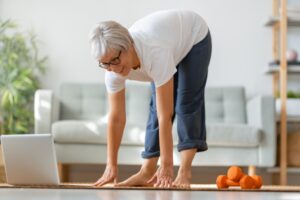Mobility and flexibility are the unsung pillars of fitness that empower you to move freely, safely, and confidently at any age or activity level. Whether you’re a beginner just starting your fitness journey or a seasoned athlete, dedicating time to mobility and flexibility can enhance your performance, prevent injuries, and improve your overall quality of life. Importantly, these benefits extend beyond the gym – they impact your mental well-being, support longevity, and make everyday movements easier. In this article, we’ll break down what mobility and flexibility mean, why they matter, and how to improve them with practical, science-backed strategies.
What Are Mobility and Flexibility?
In simple terms, flexibility is the ability of muscles and other soft tissues to stretch passively, whereas mobility is the ability of a joint to move actively through its full range of motion issaonline.com. Think of flexibility as how far you can stretch a muscle, and mobility as how well you can control a movement through that stretch. Both are closely related: if a muscle is too tight (poor flexibility), it will restrict the joint’s mobility. Good mobility actually requires both flexibility and strength/stability around the joint issaonline.comissaonline.com. You can be flexible but still lack mobility if you don’t have the strength to move through your range of motion. In short, flexibility and mobility go hand in hand to allow healthy, pain-free movement.
Why do they matter? When your muscles and joints move freely, your posture and movement patterns improve, and daily tasks feel easier. If a muscle lacks flexibility, your movement can be altered and your posture and performance may suffer, increasing the risk of injury. This isn’t just an athlete’s concern – everyday actions like reaching for a high shelf, bending to tie your shoes, or sitting comfortably all require adequate mobility and flexibility issaonline.com. By working on both, you’re investing in the foundation of functional movement that supports a high quality of life.
Performance Benefits & Injury Prevention
One of the most immediate benefits of improving your mobility and flexibility is better physical performance and a lower risk of injuries. When your joints can move through their full range and your muscles can extend without excessive tightness, you can exercise more efficiently and with better form. In fact, increasing your flexibility can improve performance in physical activities and enable your muscles to work more effectively, while also decreasing your risk of injuries. For example, flexible hips and hamstrings can help you squat deeper or run with better stride mechanics, enhancing your athletic ability.
Being limber is often called the “secret sauce” to moving safely and powerfully. Without sufficient flexibility, muscles become shortened and don’t contract as well, which can set you up for strains, muscle damage, or joint pain health.harvard.edu. Tight, imbalanced muscles (say, one side more flexible than the other) can also predispose you to injury. By incorporating stretching and mobility work, you help your joints move through their full range of motion and balance out muscle lengths, which protects you during workouts and daily activities. Even basic moves like a proper lunge or overhead press become safer and more effective when you have adequate mobility in your hips and shoulders.
It’s worth noting that not all stretching is equal when it comes to immediate performance. Experts recommend warming up with dynamic movements (moving stretches) rather than long static stretches before intense exercise, mayoclinic.org. Dynamic mobility drills – like leg swings, arm circles, or torso rotations – prepare your muscles and nervous system for action without weakening muscle fibers. Save deeper static stretching for after your workout or separate sessions, as static stretches held before explosive activities might temporarily diminish performance or strength. When done at the right time, though, flexibility training will ultimately help you perform better and more safely in the long run.
Mental Well-Being & Stress Relief
Mobility and flexibility training aren’t just about physical gains – they also offer significant mental health benefits. Stretching out tight muscles can provide a wonderful sense of relief and relaxation. By reducing muscle tension, stretching breaks the cycle of stress that builds up in our bodies. In fact, research shows that stretching is linked to increased serotonin levels – a hormone and neurotransmitter that stabilizes mood and reduces stress. This means a regular flexibility routine can help decrease feelings of anxiety and depression and promote an overall sense of well-being.
Many people find that incorporating mobility exercises like yoga or gentle stretching in their day provides a mental reset. The focus on breathing and gradual movement can be almost meditative, activating your body’s relaxation response. Over time, this mind-body practice can improve your mental resilience. You might notice you sleep better or feel more focused after a good stretching session. Even at work, taking a short stretch break can alleviate muscle stiffness from sitting and refresh your mind. The empowering takeaway is that caring for your physical mobility can directly improve your mood, reduce stress, and boost mental energy – a true win-win for body and mind research.colostate.edu.
Daily Functional Movement
One of the most practical benefits of mobility and flexibility training is how it improves your day-to-day functional movement. Functional movements are the basic actions you do in daily life – bending, twisting, reaching, walking, climbing stairs, carrying groceries, and so on. If you’ve ever felt stiff getting out of bed or struggled to squat down to pick something up, you understand how limited flexibility can interfere with daily living. The good news is that by working on your mobility, you can make these everyday activities easier and more comfortable.
Better flexibility helps your joints move freely, making tasks like lifting a child or stretching to clean that top shelf much less of a strain. According to Mayo Clinic experts, better flexibility can “improve your ability to do daily activities” with greater ease, mayoclinic.org. For instance, flexible shoulder and chest muscles help you reach overhead or behind you without pain, and mobile ankles and hips improve your balance and walking efficiency. On the flip side, if you never stretch and lead a mostly sedentary life, you may gradually lose range of motion, which can make even simple actions difficult and potentially lead to pain. research.colostatduresearch.colostate.edu. Tight muscles from long hours of sitting (hello desk jobs!) often contribute to back or neck aches. Incorporating a regular stretching routine can counteract these effects by lengthening tight areas and improving your posture, so you move and feel better during the day.
Ultimately, investing in mobility and flexibility means investing in greater independence and comfort in daily life. As one fitness expert explains, you should think of stretching from a functional standpoint: does it give you the flexibility to do your daily tasks or maintain independent living, like reaching overhead to get something from a shelf? heart.org The answer is yes – maintaining flexibility ensures you can continue to do what you need to do (and love to do) every day without unnecessary struggle.
Longevity & Healthy Aging
Maintaining mobility and flexibility is crucial for healthy aging and longevity. We often take for granted simple abilities like getting up from the floor or putting on our shoes – until those abilities become challenging. As we get older, muscles and joints naturally lose some elasticity and range of motion, but dedicated flexibility training can significantly slow this decline. In fact, stretching regularly keeps muscles long and pliable, which helps you stay limber, active, and independent as you age. It can even reduce common aches: studies have found that consistent stretching can relieve joint and back pain and improve posture and balance health.harvard.edu.
One of the most important benefits of good mobility in later years is fall prevention. When your hips, knees, ankles, and back are flexible, you’re better able to maintain balance and recover from stumbles. Harvard health experts note that improving flexibility through stretching can enhance your balance and thus reduce your risk of falling – a key factor in staying injury-free and independent in older adulthood. Programs like tai chi and yoga, which blend flexibility, balance, and strength, have been shown to significantly reduce falls in older adults mayoclinic.org. Moreover, staying mobile means you can continue to do daily tasks and hobbies safely. Older adults who lose mobility are less likely to live on their own and have higher rates of health problems, so maintaining flexibility is truly an investment in a longer, healthier life.
It’s never too late to start, either. Even people in their 60s, 70s, and beyond can improve their range of motion with regular gentle stretching and mobility exercises. Activities such as yoga have been found to help older adults maintain mobility, balance, and independence, and even confer cognitive benefits as people age. The bottom line: by nurturing your flexibility now, you’re helping your future self stay active and self-sufficient longer.
Tips to Improve Mobility & Flexibility
Incorporating mobility and flexibility training into your routine can be simple and highly rewarding. Here are some actionable tips to help you get started:
- Warm Up with Movement: Avoid stretching cold muscles. Begin with 5–10 minutes of light activity or dynamic stretches to increase blood flow. For example, perform arm circles, leg swings, or gentle torso twists. Dynamic warm-ups prepare your joints and muscles for deeper stretches and reduce injury risk.
- Stretch Regularly: Consistency is key to gaining flexibility. Experts recommend stretching all major muscle groups at least 2–3 times per week, and ideally every day. Even 10 minutes a day can make a difference. Skipping too many days means you could lose the gains you’ve made, so keep a regular schedule just like you do for cardio or strength training.
- Focus on Major Muscle Groups (Symmetrically): Target the areas that tend to get tight or that you use often – common ones include your calves, hamstrings, hip flexors, quads, chest, shoulders, and lower back. Ensure you stretch both sides of your body evenly to correct any left-right imbalances, mayoclinic.org. For instance, if you stretch your right hip, stretch the left one too.
- Use Proper Stretching Technique: For static stretches (the kind where you hold a position), ease into the stretch until you feel mild tension, and hold for about 15–30 seconds while breathing normally, research.colostate.edumayoclinic.org. Avoid bouncing, which can actually tighten your muscles or cause strain. You should feel a gentle pull, not pain – if it hurts, back off a bit. Over time, try to gradually extend your range, and if you’re older, you may benefit from holding stretches a little longer (up to ~60 seconds) for more improvement at heart.org.
- Mix Dynamic and Static Stretching: Both mobility and flexibility exercises have their place. Do dynamic stretches (moving through ranges of motion) as part of warm-ups or functional training – for example, walking lunges with a twist, high knees, or hip circles mimic movements and improve joint mobility. Then incorporate static stretches after workouts or in dedicated sessions to increase flexibility – for example, holding a hamstring stretch, calf stretch, or chest-opening stretch for 30 seconds each. This one-two punch will improve active mobility and passive flexibility together.
- Try Yoga or Tai Chi: These activities naturally combine stretching with strength, balance, and mindfulness. Yoga, for instance, encourages moving through a wide range of positions, which improves flexibility in multiple muscle groups and joints. As a bonus, it can reduce stress and improve balance and coordination. Tai chi involves gentle, flowing movements that can especially help older adults improve flexibility and reduce fall risk. Consider adding a yoga session or a tai chi class to your weekly routine for an enjoyable way to boost mobility.
- Listen to Your Body: Perhaps the most important tip – stay attuned to how you feel. Mobility will improve gradually, so be patient and consistent. If a particular stretch or movement causes sharp pain, stop and modify it. It’s normal to feel tension when stretching, but you should not feel anything more than mild discomfort. Over time, “your body can bounce back” and increase its range of motion, even if you’ve been stiff for years – it just takes steady, proper practice. Celebrate small improvements and remember that any progress in flexibility will make daily life and exercise feel easier.
By following these tips, you’ll be well on your way to improving your mobility and flexibility in a safe, effective manner. Remember that mobility and flexibility training is a lifelong journey, not a one-time task. The effort you invest will pay off in the form of smoother movement, fewer aches, and the confidence that your body can meet the demands of both everyday life and the activities you love. Stay consistent, stay mindful, and enjoy the empowering benefits of moving freely!





